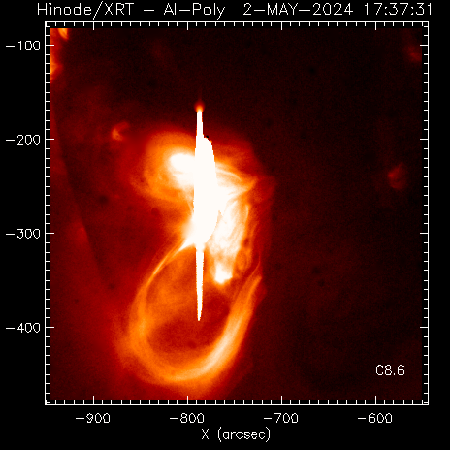
A look from XRT at the biggest AR of solar cycle 25 (so far). Watch the movie above or click here for the youtube version.
There and Back Again -- An Active Region's Journey
|
Solar activity remains moderate as June starts despite 15 Active Regions (ARs) on the solar disk. The largest AR on the disk approaches the center quieter than last solar rotation. Sunspots take two weeks to traverse the solar disk, which means in another two weeks after the spot disappears, it can reappear on the Earth facing disk once more. In this case, AR13697 is renamed from the initial naming AR13664. This spot number may sound familiar as this spot was extremely active at the beginning of May. AR13664 rotated onto the solar disk on May 1st as a small sunspot group of 5 spots. However, AR13664 or ‘64 grew rapidly 15 spots over the next two weeks. There are an average of 10 sunspots per sunspot group, so this region became a bit larger than average (NASA, 2017). Over that two weeks, May 1st through May 14th, ‘64 produced 11 X-class flares, 61 M-class flares, and 39 C-class flares. The largest was an X8.79 on May 14 which was occulted, or over the limb. In addition to a high level of activity, ‘64 impacted Earth with the first G5 rated geomagnetic storm of solar cycle 25. This produced aurora reported using photography as far south as Florida and as far north as India. Commonly, aurora are seen in green and purple/red, however, there could be yellows and blues captured as well. The colorful phenomenon occurs when a charged particle, such as an electron or a proton, hits a molecule in the atmosphere, oxygen and nitrogen. This causes energy to be transferred from the particle to the molecule resulting in the molucle emitting light (green, yellow, and purple for oxygen and blues for nitrogen). The Hinode operations team discussed which active region to watch carefully, either AR13663 or AR13664. First, we observed ‘64 from May 2nd until May 4th, switched to ‘63, and then returned to ‘64 on May 9th for the duration of the satellite’s visibility on May 12th. Hinode operators need to consider the safety and efficiency of instruments. In this case, the X-Ray Telescope (XRT) and the Extreme-ultraviolet Imaging Spectrograph (EIS) had to consider the use of the Solar Optical Telescope (SOT) which does not observe the limbs of the Sun well. The video illustrates the time we observed and features the Al-poly filter from XRT. Hinode is an older satellite and generates debris on the observation filters, creating spots on the video. Note that the video also tracks the flares from ‘64. Keywords: AR Tracking, Flare Filters: Al_Poly |
(Prepared by Rhiannon Fleming and Aki Takeda )
The XRT instrument team is comprised of SAO, NASA, JAXA, and NAOJ.
| Back | Archive | Next |